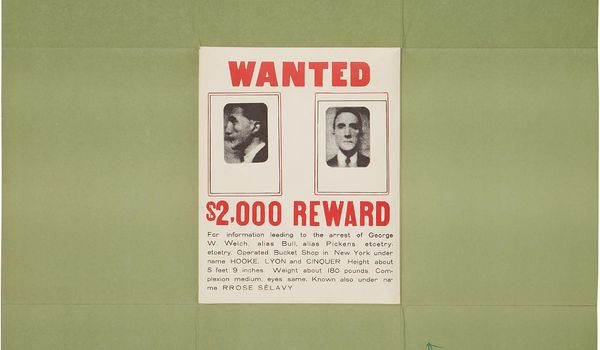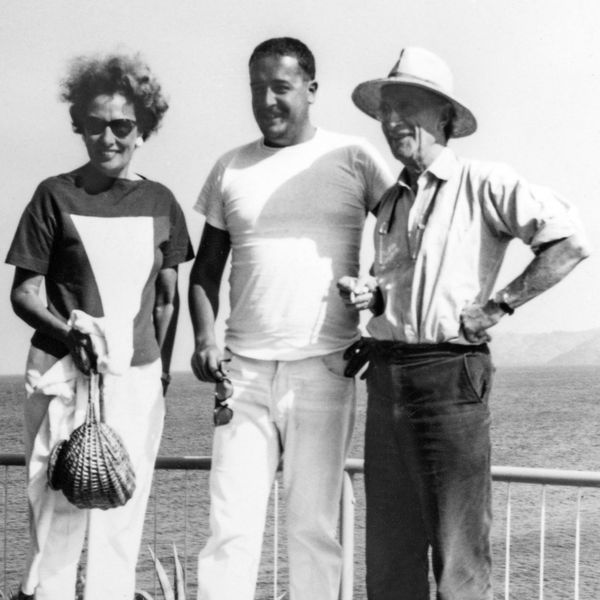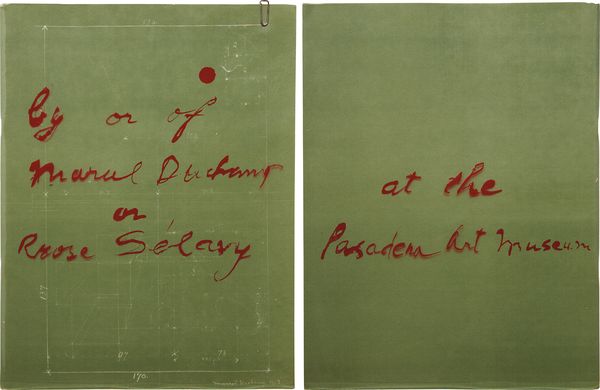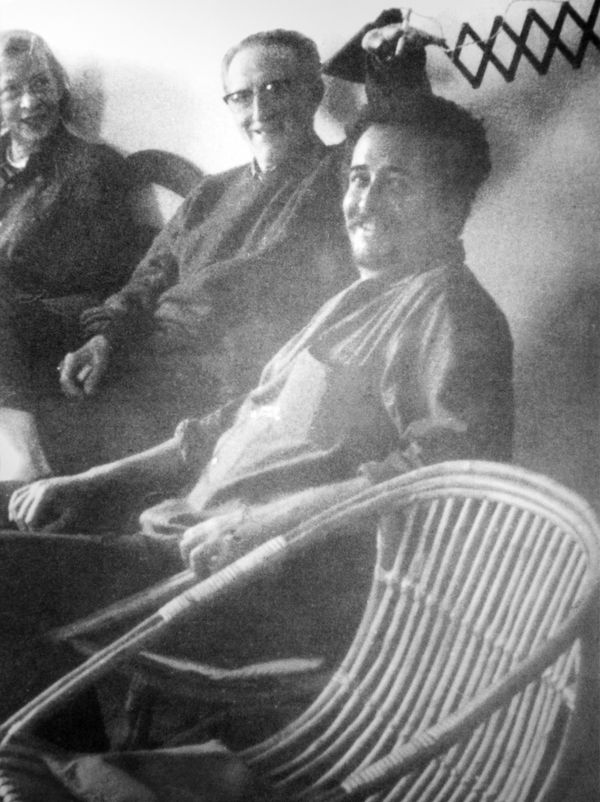Detail from Marcel Duchamp A Poster Within a Poster, for "Marcel Duchamp: A Retrospective Exhibition", 1963
Marcel Duchamp's first and long-awaited retrospective in the United States was held in Los Angeles at the Pasadena Art Museum from 8 October - 3 November 1963. Featured in the show of 114 items were Duchamp's most iconic works: the seminal readymade Fountain (a 1950 replica in the original size, as the 1917 original was lost), a replica of The Large Glass (the original was too fragile to travel) and Bicycle Wheel (4th version), among others.
Duchamp designed the exhibition's poster, incorporating a work he had produced in 1923, WANTED: $2,000 REWARD, a Rectified Readymade in which he modified a wanted poster found in a New York restaurant with photographs of himself in profile and full-face. Lot 71 from our October Editions & Works on Paper sale includes this edition A Poster within A Poster and the retrospective exhibition catalogue, these examples personally inscribed by Marcel Duchamp to his good friend, the Peruvian artist Emilio Rodríguez-Larraín.
Emily McFadden, Emilio Rodríguez-Larraín and Marcel Duchamp. Courtesy of the Estate of Emilio Rodríguez-Larraín.
Although highly regarded by the younger generation of artists at the time of this exhibition, Duchamp was not yet recognized widely as the pivotal art figure he is today. In the catalogue forward, the acting director of the Pasadena Art Museum wrote, "The man inspires the highest regard (often the love) of those who know him; the public so often regards his work as anathema." This younger generation's support is evidenced by the attendees of the exhibition's opening gala, who included Los Angeles artists Ed Ruscha, Billy Al Bengston, Larry Bell, the actor photographer Dennis Hopper and, from New York, Andy Warhol—who rarely traveled. Among the younger artists who shared a friendship with Duchamp was Rodríguez Larraín, to whom this particular work is inscribed.
Marcel Duchamp A Poster Within a Poster, 1963
Although not widely known internationally, Emilio Rodríguez-Larraín is considered one of the most innovative artists of his generation. He, like many of his contemporaries, would study in Europe and live abroad for thirty years before returning to his native Peru. While in Europe, he met the intelligentsia of the time; in 1960, he met Duchamp and began to form what would become a profound friendship.
As an artist, Rodríguez-Larraín continually evolved and incorporated disparate ideas and influences to produce a varied and impressive oeuvre. His early work drew upon geometric forms and traditional Peruvian art, later incorporating ideas explored while in European artistic and intellectual circles, and finally referencing his training as an architect designing large-scale, site-specific sculptures—unfortunately, these later sculptures were not realized due to the rise of the tumultuous political moment of the armed wing Peruvian Communist Party known as the Sendero Luminoso (Shining Path).
Despite the setbacks to the realization of these projects, he had long "...[ assigned] more importance to the process of creation than to the actual result," and in later works employed techniques from Surrealism such as the "guided fate," where far from a will to represent, the work is a product of chance with a minimal intervention from the artist, who recovers forms that are created by nature during a process of free association. With such ideas associated to the more radical avant-garde of the 20th century, there is an aspect of Rodríguez-Larraín's work that links him directly to the artistic production based on ideas, influenced strongly by the concept of the Readymade, which Duchamp famously invented.
One of his least-known works humorously made in collaboration with Duchamp, titled, not in an ironic manner, a Monnaie du Pape (The Father's Coin), references the status of Duchamp as the "Father of Conceptual Art." The work consists of a check in the name of Marcel Duchamp from the Bank of New York, which was written out to 'Rodriguez Larrain' in the amount of $10. The check was housed in a wooden box with a plaque affixed to the front, inscribed 'Duchampmade ERLarrain'.
Rodríguez-Larrín refers to this work in the following terms, translated from Spanish: "I have created a 'ready‐made' with the help of Marcel Duchamp; I made him write out a check; I told him 'give me dollars', that can also be said as 'ten dollars'; have ten, and then he wrote out a check, from his bank, that said 'ten dollars' – 'take dollars' – and I made a box with this check, in Rome in the year 1963, which I did not label 'ready-made' but 'Duchamp made', by Emilio Rodríguez Larraín. When Marcel saw this, he was delighted and asked me if he could also sign it."
Alexina "Teeny" Duchamp, Marcel Duchamp and Emilio Rodríguez-Larraín in Cadaqués, Spain. Courtesy of the Estate of Emilio Rodríguez-Larraín.
From the time of their meeting and well after his death, Duchamp dramatically influenced Rodríguez-Larraín in art and in life. In a charming anecdote, Herman Braun-Vega (a fellow artist and close friend of Rodríguez-Larraín) recounted a chess tournament in Llança reserved only for Spaniards. Rodríguez-Larraín had the idea of taking both Marcel Duchamp and Man Ray to compete and, when registering the two for the tournament, changed their names to Manolo Rayo and Marcelo del Campo and said they were both deaf mutes so that the Spaniards wouldn't identify their accents. Rodríguez-Larraín orchestrated the whole thing and Duchamp and Man Ray finished respectively in 1st and 2nd place.
This playful mischief is exemplified in lot 71 of the upcoming Editions & Works on Paper sale, the edition A Poster Within a Poster and the accompanying catalogue. In his personal inscription, Duchamp wrote, as translated from French: "For Emilio Rodriguez from my jail Much love from Marcel Duchamp" and on the catalogue "This was at the time of the pipe; now long live to cigars much love from Emilio Marcel."




